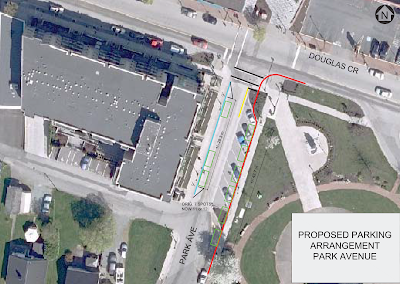Over the past several days, I’ve posted about what happened at Monday night’s Council meeting including placing restrictions on new thrift stores and donation bins, plus development projects that were giving the green light.
Langley City Council adopted two park master plans at Monday’s meeting. The first plan adopted was for City Park.
One of the things that was heard loud and clear was that residents in the community didn’t want articificial turf fields, field lighting, and green space removed for extra parking. There was also a strong desire to see a covered lacrosse box.
This plan adopted covers off all these items. As you can see in the following pictures, one of the proposed parking areas has been removed from the 10-year funding window of this plan. The plan also states that “new parking areas are intended to be phased in overtime on an as needed basis and designed to minimize impact on the environment by utilizing features such as permeable paving, planting islands and bioswales.”
 |
| City Park Master Plan. Select image to enlarge. |
 |
| Phasing and budget of City Park Master Plan. Select image to enlarge. |
The second parks plan adopted was for Buckley and Penzer Parks.
The plan is very much focused on creating an older youth-oriented action park near 200th Street, a passive nature area, and upgraded sports fields at Buckely Park. The proposed multi-use path throughout the parks will connect 200th Street to Surrey’s Hi-Knoll Park.
 |
| Buckley and Penzer Parks Master Plan. Select image to enlarge. |
 |
| Buckley and Penzer Parks Master Plan phasing and budget. Select image to enlarge. |
One of the concerns expressed by members of council was how people will safely get across 200th Street into Penzer Parks. The parks plan does include a trail which will focus people down to the 48th Avenue intersection, but a plan will likely need to be developed around making 200th Street safer near Penzer Park.
Rear-in, angle-in parking hasn’t worked out very well in our downtown core as the majority of angled parking is front-in angle parking. Council approved making all parking front-in angle parking in the downtown with the changes shown in the following pictures. This will result in a net gain of three parking spots.
 |
| Changes to parking lot at Fraser Highway near Glover Road. |
 |
| Changes to parking along Park Avenue. |
City council also received a report on the results of the 2016 community survey. I’ll be posting about this report next week.
Discrimination and prejudice is still very much alive in our world. Langley City Council decided to take a stand, and say that we value all people in our community by passing the following motion.
WHEREAS The City of Langley is an inclusive and diverse community that acknowledges and respects all people regardless of their colour, race, region, national or ethnic origin, age, sex, sexual orientation, gender identity or expression, or mental or physical disability; and
WHEREAS The Rainbow Flag is an international symbol of inclusiveness and diversity; and
WHEREAS The Rainbow Flag is general flown during summer months by municipalities throughout the region, the province, and our nation;
NOW THEREFORE BE IT RESOLVED THAT City of Langley staff amend Council Policy CO-33 ‘Flag Raising Policy’ by no later May 31, 2017 to include adequate and appropriate guidelines and parameters which will result in the flying of a Rainbow Flag for a one week period annually anytime during the month of June or July as an expression of City Council’s sentiments.
The only person who didn’t vote in favour of the motion was Councillor Jack Arnold.



















